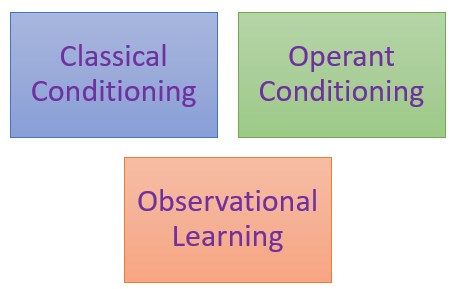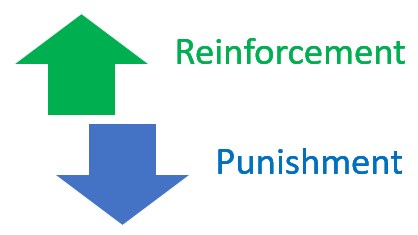Types of Behavioral Learning
There are three types of behavioral learning:
- Classical Conditioning
- Operant Conditioning
- Observational Learning
About the Three Types of Behavioral Learning
Both classical and operant conditioning are forms of associative learning; meaning associations are made between events that occur together. Observational learning is learning by observing others. Although rooted in behaviorism, the observational learning theory is considered to be a bridge between behaviorism and cognitive learning theories.
Classical Conditioning – Learning through association
Operant Conditioning – Learning through consequences
Observational Learning – Learning through observation
Behaviorism
Behaviorism is the school of thought that seeks to measure only observable behaviors. Hence, it only examines outward behavior when trying to understand if learning occurred.
Behaviorism stems from the work of John Watson, B.F. Skinner, and Ivan Pavlov. These Behaviorism theorists believe that knowledge exists independently and outside of people. They view the learner as a blank slate who must be provided the experience. Behaviorists believe that learning actually occurs when new behaviors or changes in behaviors are acquired through associations between stimuli and responses. Thus, association leads to a change in behavior.
There are two core theories that stem from Behaviorism;
Classical Conditioning – Ivan Pavlov
Operant Conditioning – B.F. Skinner
As indicted above, observational learning is a bridge between behaviorism and cognitive learning.
The Three Types of Behavioral Learning
Classical Conditioning
Classical conditioning is a learning process in which an association is made between two stimuli. With classical conditioning, two stimuli are linked together to produce a new learned response. One stimulus is a neutral and the other evokes a natural response. After learning the association, the neutral stimulus elicits the conditioned response.
The theory of classical conditioning was introduced by Russian physiologist, Ivan Pavlov. Pavlov conducted his classic experiment involving dogs. In his experiment, he conditioned the dogs to associate the sound of a bell with the presence of food. He paired the smell of food which was the naturally occurring stimulus with the neutral stimulus of a ringing bell. Once an association had been made between the two, the sound of the bell alone could elicit a response. The dogs responded to the sound of the bell by salivating.
In his experiment, the bell was neutral stimulus since the bell itself did not produce the dogs’ salivation. However, by pairing the bell with the stimulus of the smell of the food, which did produce the salivation response, eventually, the bell by itself was able to trigger the salivation response. Thus, the “conditioning” was achieved when the sound of the bell on its own was able to make the dogs salivate in anticipation for the food.
Operant Conditioning
Operant conditioning is a learning process in which responses are controlled by consequences. The likelihood of a certain response occurring is either increased or decreased due to either a reinforcement or a punishment consequence. A reinforcement helps to increase a behavior, while a punishment helps to decrease a behavior.
The term operant conditioning was coined by a behaviorist B.F. Skinner. Skinner conducted experiments with rats using a device called the Skinner box. The box was a cage set up so the rats could automatically get a food reward if they stepped on a lever. The lever caused food to be released. From these experiments, Skinner observed how reinforcement could lead to increases in behaviors where punishment would result in decreases in behaviors.
Reinforcement
Reinforcement is a consequence that increases the likelihood a response will occur. If you are using reinforcement, you are trying to increase a behavior.
There are two types of reinforcement.
- Positive reinforcement
- Negative reinforcement
Positive means adding a stimulus, while negative means removing a stimulus. Thus, positive reinforcement is the addition of a good stimulus after a response in order to encourage the response to continue. An example of this would be giving someone praise after a desired behavior is displayed.
In contrast, negative reinforcement is the removal of an undesirable stimulus after a response so that the response will occur more often. An example of this would be fastening your seatbelt in a car so the beeping sound will stop. Since the undesirable stimulus is removed when you fasten your seatbelt, you are encourage to fasten your seatbelt.
Negative reinforcement is often confused with punishment because of its name. However, negative reinforcement involves removing a negative consequence to increase a behavior, while punishment seeks to decrease a behavior.
Punishment
Punishment is a consequence that decreases the likelihood a response will occur. If you are using punishment, you are trying to decrease a behavior.
There are two types of punishment:
- Positive punishment
- Negative punishment
Positive punishment is the addition of an undesirable stimulus after a response so that the response will occur less or stop. An example would be to give someone extra work for misbehaving.
Negative punishment is the removal of a pleasing stimulus after a response so that the response will occur less or stop. An example would be taking away television or video games from a child for misbehaving so he or she will stop misbehaving.
Observational Learning
Observational learning or modeling is a process in which learning occurs through observing the behaviors of others and then imitating those behaviors. Observational learning allows for learning without any direct change to behavior. This is why it is not considered strict behaviorism. It is more of a link between behaviorism and cognitive learning.
Observational learning is associated with the work of Albert Bandura and his social learning theory. The social learning theory suggests that learning occurs through observation and interaction with other people.
Bandura first demonstrated observational learning in his famous “Bobo-doll” experiment. In this experiment, children imitated the actions of adults. After seeing adults hit a doll, children would assault the Bobo-doll. The experiment showed that children learned the aggressive behavior by observing it.
Links




